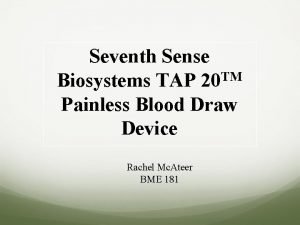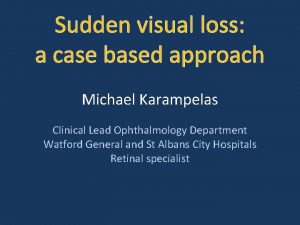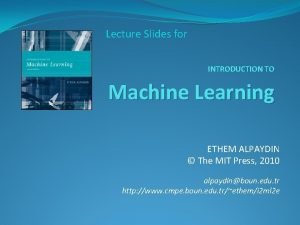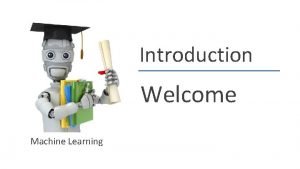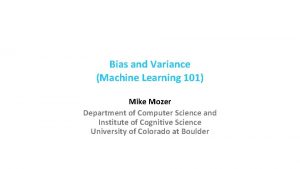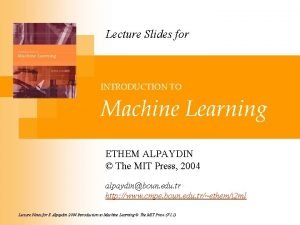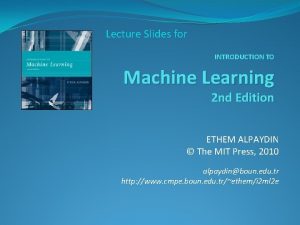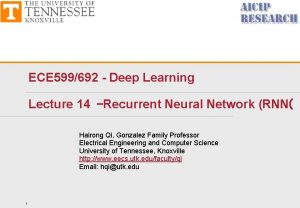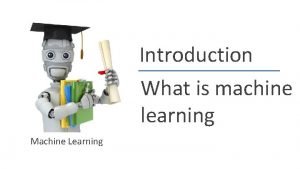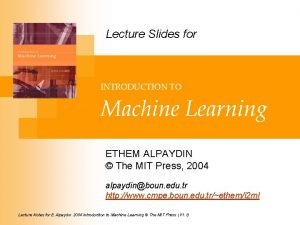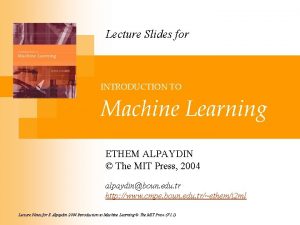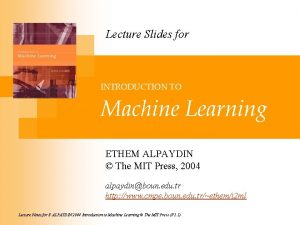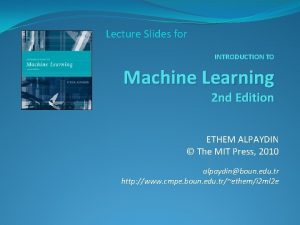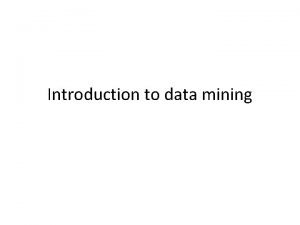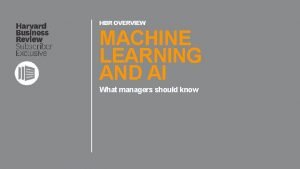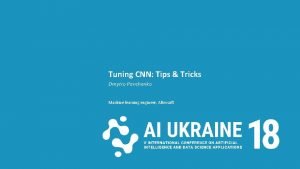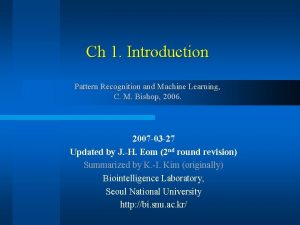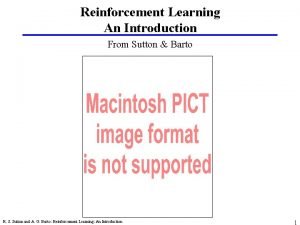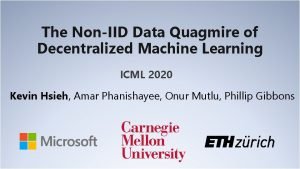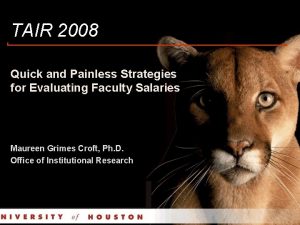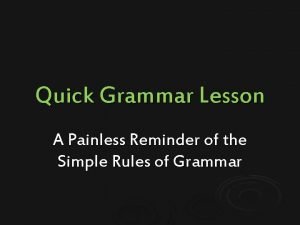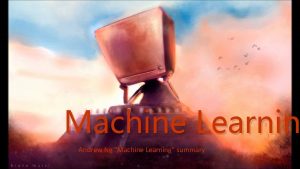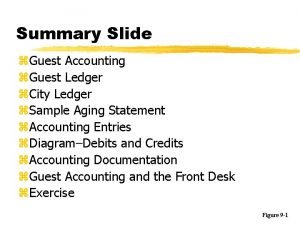Quick and Painless Introduction to Machine Learning Guest





















































- Slides: 53

Quick and Painless Introduction to Machine Learning Guest Star: David Weigl! J. Stephen Downie Xiao Hu School of Information Sciences Faculty of Education University of Illinois at Urbana-Champaign University of Hong Kong jdownie@illinois. edu xiaoxhu@hku. hk 1

Agenda • Million Mile View of Machine Learning o Machine learning and Data Science o Supervised vs. unsupervised learning § Decision Tree; Support Vector Machines (SVM); K-Nearest Neighbor (k. NN) o Experimentation • Friendly ML Tool: o Weka: Machine learning <<We will work with this one later • Wrap Up and Discussion 2

Machine Learning and Data Science • Data Science o Data analytic thinking o Decision supporting o Discovery-based • Data management: o Collection, Curation, Access • Machine learning o Methods of big data analysis o Automated discovery from data o Hypothesis generation Image credit: Berlin Big Data Center • Statistics o Hypothesis testing 3

Examples of ML • Spam email detector • Recommender systems • Fraud detection • Categorizing news stories as finance, weather, entertainment, sports, etc. • Categorizing library materials by catalogs • Categorizing music by mood • Decide whether to play golf according to weather conditions • Market segmentation • Group library patrons into different clusters 4

WEKA: the bird • The Weka or woodhen (Gallirallus australis) is an endemic bird of New Zealand. (Source: Wiki. Pedia) Copyright: Martin Kramer (mkramer@wxs. nl) 5

WEKA: The tool n n Machine learning/data mining software written in Java (distributed under the GNU Public License) Used for research, education, and applications Complements “Data Mining” by Witten & Frank Main features: Comprehensive set of data pre-processing tools, learning algorithms and evaluation methods u Graphical user interfaces u Environment for comparing learning algorithms u 6

The Book • Witten, I. H. (2011). Data Mining: Practical Machine Learning Tools and Techniques. Morgan Kaufmann ebook in HKU Lib 7

8

Machine Learning in One Slide 9

Supervised vs. Unsupervised Learning • Supervised o. Manually label a subset of the data objects o. Use those class labels to “train” a machine learning algorithm: GROUNDTRUTH o. Train/Test experiments • Unsupervised o. Choose distance metric (e. g. , Euclidian distance) o. Choose (or don’t) number of classes o. Partition into classes that minimize withinclass distance and maximize betweenclass distance 10

Common Methods Supervised • Decision trees • Random forests • Support vector machines • Bayesian • Neural networks • Nearest neighbor • … Unsupervised • K-means clustering • Mixture model clustering • Hierarchical clustering • Matrix factorizations • …. 11

Input Data: Unsupervised Item of Interest Feature 1 Feature 2 Feature. X Object. Name 1 Value 2 Value. X Object. Name 2 Value 1 Value 2 Value. X Object. Name. X Value 1 Value 2 Value. X Bird (Band #) Height (cm) Mass (kg) Colour 1 25 0. 75 Black 2 30 1 Brown 3 300 200 Yellow 12

Input Data: Supervised Item of Interest GROUNDTRUTH CLASS Feature 1 Feature 2 Feature. X Object. Name 1 Label 1 Value 2 Value. X Object. Name 2 Label 2 Value 1 Value 2 Value. X Object. Name. X Label 3 Value 1 Value 2 Value. X Bird (Band #) SPECIES Height (cm) Mass (kg) Colour 1 Daffy 25 0. 75 Black 2 Woody 30 1 Brown 3 Big 300 200 Yellow 13

Classification Methods Supervised learning Decision Tree Support Vector Machines (SVM) K-Nearest Neighbor (k. NN) ‹#›

Illustrating Classification Task Two steps 15

What is a Decision Tree? • The classification model is represented as a tree o. Each node represents a decision based on one attribute of data o. Given a new instance of the problem, following a path in the tree will give a class label Refund Yes No NO Mar. St Single, Divorced Tax. Inc < 80 K NO > 80 K YES NO 16 Married

An Example of Decision Tree Problem: to label each person as to whether they will cheat on their income tax Class label Splitting Attributes Refund Yes No NO Mar. St Single, Divorced Tax. Inc < 80 K Training Data NO > 80 K YES NO 17 Married Model: Decision Tree

Decision Tree Classification Task Decision Tree 18

Apply Model to Test Data 19

Decision Trees as Classifiers • Strengths o. One of the most popular data mining tools o. Easy to understand § important for model evaluation and communication to non-DM-savvy stakeholders o. Computationally cheap o. Almost all data mining packages include DTs • Weakness o. Trees grow too big when there are many features o. Cannot output probabilities of predictions 20

Support Vector Machines SVM 21

Support Vector Machines • Separate the data using a linear decision boundary (a line) • There are quite many possible solutions • Which one is better? • How do you define “better”? 22

Support Vector Machines • Find a boundary that maximizes the margin for both classes => B 1 is better than B 2 If an unknown data is here, B 2 will classify it to the wrong class whereas B 1 will get it correct. 23

Support Vectors Support vectors • Support vectors are the training examples that are located on the margins • Only support vectors determine the decision boundary (so SVM is a fast algorithm) 24

Nonlinear Support Vector Machines • What if decision boundary is not linear? 25

Nonlinear Support Vector Machines • Transform data into higher dimensional feature space o. Such transformation is done through a “kernel” function o. Linear SVM is the SVM with a linear kernel 26

SVMs as Classifiers • Strength o High tolerance to noisy data o Flexibility in data representation o Probabilistic prediction result o Scalability: successful on extremely large problems o Successful on a wide array of real-world data • Weakness o Require a number of parameters for each kernel type o Interpretability § Easy interpretation for linear kernel § Difficult to interpret the model generated by nonlinear kernels 27

k-NN: Instance-based learning • In contrast to learning methods that construct a general, explicit target function when training examples are provided, e. g. decision tree, SVM • Instance-based learning methods simply store the training examples during training process • Sometimes called “lazy” learners because they build no model (function) and delay processing the training data until new examples must be classified. ‹#›

K-Nearest Neighbor (k-NN) • K-NN: an instance-based learning method • Training process: o. Add in all training examples • Classification process: o. Given a new example x (uncolored in the picture below), compare the similarity between x and all training examples, choose the majority-voted category label in the k nearest training examples K=1, prediction=blue K=2, prediction=? K=3, prediction=red 29

Distance between Two Data Samples • Vector representation o Vector: a row in a data table (a 1, a 2, … an) o Model the problem as a n-dimensional space for n attributes § In the mood label problem, each data sample can be considered a vector, where the dimensions are as follows: Album_1 ; Album_2 ; Album_3; … § and an sample vector could be ( 0, 1, …. ) § Represented in a 3 -dimensional space Album_1 1 Album_2 1 0 (0, 1, 1 ) 1 Album_3 30

Distance between Two Data Samples • Distance/similarity measures o. Euclidean distance a=(1, 2) d α ‹#31› b=(4, 2)

k. NN as classifier • Strengths o. No assumptions: all depends on the distance between data examples o. Simple • Weakness o. Sensitive to noisy training data § If your nearest neighbor’s label is wrong… o. Cost of classifying new instances can be high § Nearly all computation takes place at classification time rather than when the training examples are first encountered. § Has to search all examples to retrieve the k nearest examples 32

Clustering With Try At Home Bonus: The Iris dataset 33

Unsupervised Learning: Clustering • A clustering is a set of clusters • Finding groups of objects such that the objects in a group will be similar to one another and different from the objects in other groups Inter-cluster distances are maximized Intra-cluster distances are minimized 34

Unsupervised Learning: Clustering • Two major kinds of methods • hierarchical and partitional sets of clusters • Partitional Clustering o. A division of data objects into non-overlapping subsets (clusters) such that each data object is in exactly one subset o. K-Means • Hierarchical clustering o. A set of nested clusters organized as a hierarchical tree 35

Clustering the Musical Wild • Essid, S, G. Richard and B. David, "Hierarchical Classification of Musical Instruments on Solo Recordings, " 2006 IEEE International Conference on Acoustics Speech and Signal Processing Proceedings, Toulouse, 2006, pp. V-V. Available: doi: 10. 1109/ICASSP. 2006. 1661401. 36

Try At Home Clustering Example • Famous Iris dataset o. Used in every ML class o. Small and easy to understand • Data Examples and Helpful Handouts: ohttps: //goo. gl/m. F 79 u. T odownie_ML_oxford_2017_iris_handouts. pdf oweka_hands_on_key_classification. pdf 37

Hierarchical Clustering Dendrogram 38

Link Type in Hierarchical Clusterin • How to define inter-cluster distance? Distance • Single-linkage • Complete-linkage • Average-linkage 39

Partitional Clustering Original Points A Partitional Clustering 40

Clustering in WEKA • WEKA contains multiple common clustering schemes: • k-Means, EM, Hierarchical clustering • Visualization of results • Clusters can be visualized and compared to “true” clusters (if given) • First step: load in data 41

Experimentation • N-Fold Cross-validation o. Not “fair” to train model, then test the model using the same data o Need to have separate TRAIN and TEST data • Problem: groundtruth data can be hard to create limiting amount available with which to train then test • Cross-validation splits one collection into n-fold distinct sets • Model built with one of the subsets held back for testing • Different subset held back each of n-fold subsets • Results averaged 42

Partition Data Into Training and Test Sets Challenges: 1) what if by accident you selected a particularly easy/hard test set? 2) Do you have an idea of the variation in model accuracy due to different training datasets? Graph credit: Foster Provost in New York University 43

Cross-Validation (CV) Five-fold CV Final performance = average (T 1, …T 5) Graph credit: Foster Provost in New York University 44

3 -Fold Example Fold #1 FILE m 000001. wav m 000002. wav m 000003. wav m 000004. wav m 000005. wav m 000006. wav m 000007. wav m 000008. wav m 000009. wav m 000010. wav m 000011. wav m 000012. wav m 000013. wav m 000014. wav m 000015. wav GROUNDTRUTH MOOD Wistful_brooding Cheerful_fun Silly_quirky Wistful_brooding Rousing_rowdy Cheerful_fun Wistful_brooding Silly_quirky Firey_intense Silly_quirky SPLIT A A A B B B C C C 45 ROLE TEST TEST TRAIN TRAIN TRAIN

3 -Fold Example Fold #2 FILE m 000001. wav m 000002. wav m 000003. wav m 000004. wav m 000005. wav m 000006. wav m 000007. wav m 000008. wav m 000009. wav m 000010. wav m 000011. wav m 000012. wav m 000013. wav m 000014. wav m 000015. wav GROUNDTRUTH MOOD Wistful_brooding Cheerful_fun Silly_quirky Wistful_brooding Rousing_rowdy Cheerful_fun Wistful_brooding Silly_quirky Firey_intense Silly_quirky SPLIT A A A B B B C C C 46 ROLE TRAIN TRAIN TEST TEST TRAIN TRAIN

3 -Fold Example Fold #3 FILE m 000001. wav m 000002. wav m 000003. wav m 000004. wav m 000005. wav m 000006. wav m 000007. wav m 000008. wav m 000009. wav m 000010. wav m 000011. wav m 000012. wav m 000013. wav m 000014. wav m 000015. wav GROUNDTRUTH MOOD Wistful_brooding Cheerful_fun Silly_quirky Wistful_brooding Rousing_rowdy Cheerful_fun Wistful_brooding Silly_quirky Firey_intense Silly_quirky SPLIT A A A B B B C C C ROLE TRAIN TRAIN TRAIN TEST TEST 47

About Our Tool • Weka o Machine Learning Group at the University of Waikato, Hamilton, New Zealand o http: //www. cs. waikato. ac. nz/ml/weka/ o Has EXCELLENT associated book § Witten, I. , E. Frank, and M. Hall (2011). Data Mining: Practical Machine Learning Tools and Techniques, Third Edition. New York: Morgan Kaufmann. § http: //www. amazon. com/exec/obidos/ASIN/0123748569/departmofcompute ‹#›

Classification Results (1) • Confusion matrix PREDICTED CLASS Class=Yes ACTUAL CLASS Class=No a a: TP (true positive) Class=No b: FN (false negative) c: FP (false positive) b d: TN (true negative) c d • Performance measures 49

Classification Results (2) • MIREX 2007 o http: //www. music-ir. org/mirex/results/2007/am_tzan. eval. txt o Winner system: GT: George Ttzanetakis, University of Victoria, Canada o Classification Model: Support Vector Machine (SVM) 50

Unsupervised Learning: Clustering • A clustering is a set of clusters • Finding groups of objects such that the objects in a group will be similar to one another and different from the objects in other groups Inter-cluster distances are maximized Intra-cluster distances are minimized 51

Unsupervised Learning: Clustering • Two major kinds of methods • hierarchical and partitional sets of clusters • Partitional Clustering o. A division of data objects into non-overlapping subsets (clusters) such that each data object is in exactly one subset • Hierarchical clustering o. A set of nested clusters organized as a hierarchical tree 52

Most Important Take. Aways • Be fearless and have fun • Think spreadsheet for your data o A row for each thing in world you are interested in o One column to label the things in world o X number of columns, one for each FEATURE o For SUPERVISED ML one more column with GROUNDTRUTH • No magic feature set • More data is better! • N-fold to separate TRAIN and TEST data • Supervised vs. Unsupervised • Stay tuned for lab with more interesting cases 53
 Shake the papaya down lyrics
Shake the papaya down lyrics Touch activated phlebotomy
Touch activated phlebotomy Sudden painless loss of vision
Sudden painless loss of vision Ahsan mukhtar
Ahsan mukhtar Painless killing of a patient suffering
Painless killing of a patient suffering Dr hasan syed
Dr hasan syed Cf
Cf Quick find algorithm
Quick find algorithm Velocity and acceleration quick check
Velocity and acceleration quick check Inductive and analytical learning
Inductive and analytical learning Analytical learning vs inductive learning
Analytical learning vs inductive learning Eager vs lazy
Eager vs lazy Introduction to azure ml
Introduction to azure ml Concept learning task in machine learning
Concept learning task in machine learning Analytical learning in machine learning
Analytical learning in machine learning Pac learning model in machine learning
Pac learning model in machine learning Pac learning model in machine learning
Pac learning model in machine learning Instance based learning in machine learning
Instance based learning in machine learning Inductive learning machine learning
Inductive learning machine learning First order rule learning in machine learning
First order rule learning in machine learning Deep learning vs machine learning
Deep learning vs machine learning Introduction to machine learning ethem alpaydin
Introduction to machine learning ethem alpaydin Andrew ng introduction to machine learning
Andrew ng introduction to machine learning Andrew ng intro machine learning
Andrew ng intro machine learning High bias low variance introduction to machine learning
High bias low variance introduction to machine learning Introduction to machine learning ethem alpaydin
Introduction to machine learning ethem alpaydin Ethem alpaydin
Ethem alpaydin Introduction to machine learning slides
Introduction to machine learning slides Lstm lecture
Lstm lecture Machine learning definition andrew ng
Machine learning definition andrew ng Introduction to machine learning ethem alpaydin
Introduction to machine learning ethem alpaydin Introduction to machine learning ethem alpaydin
Introduction to machine learning ethem alpaydin Introduction to machine learning ethem
Introduction to machine learning ethem Introduction to machine learning slides
Introduction to machine learning slides Welcome address for webinar sample
Welcome address for webinar sample Cuadro comparativo entre e-learning b-learning y m-learning
Cuadro comparativo entre e-learning b-learning y m-learning Mealy and moore machine
Mealy and moore machine Chapter 10 energy work and simple machines answer key
Chapter 10 energy work and simple machines answer key Machine learning and data mining
Machine learning and data mining Hbr machine learning
Hbr machine learning Machine learning tips and tricks
Machine learning tips and tricks Cm bishop pattern recognition and machine learning
Cm bishop pattern recognition and machine learning Finite state machine vending machine example
Finite state machine vending machine example Moore machine
Moore machine Unpacking and storing guest luggage
Unpacking and storing guest luggage Dialogue receptionist and guest
Dialogue receptionist and guest Procedure of welcoming the guest
Procedure of welcoming the guest Conversation for booking a room in hotel
Conversation for booking a room in hotel Guest greeting
Guest greeting How will you bill and deliver the guest laundry
How will you bill and deliver the guest laundry Opl in housekeeping
Opl in housekeeping Tony wagner's seven survival skills
Tony wagner's seven survival skills Sutton and barto reinforcement learning
Sutton and barto reinforcement learning Bsp classification
Bsp classification

